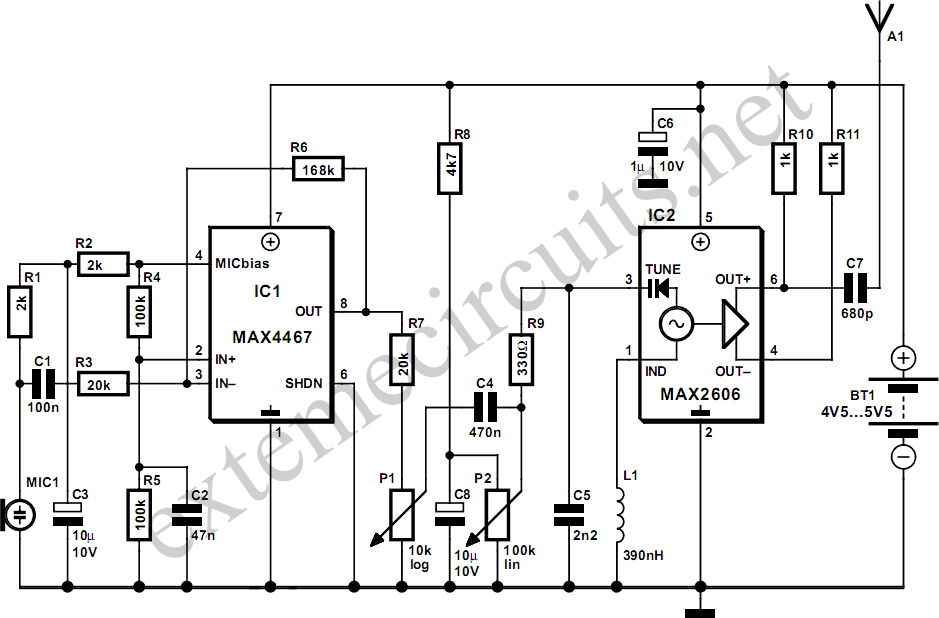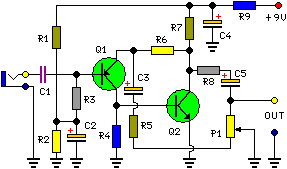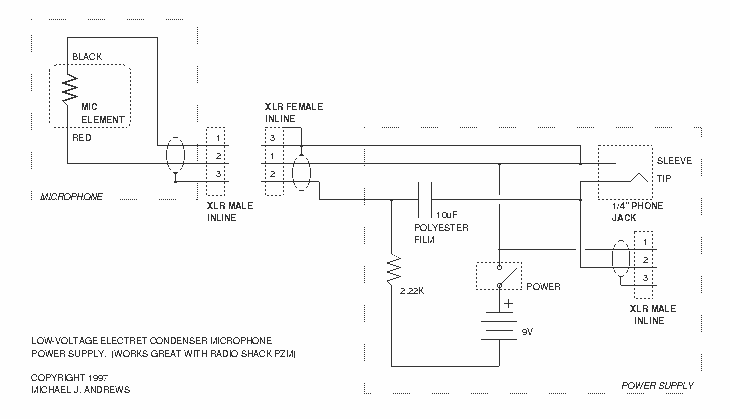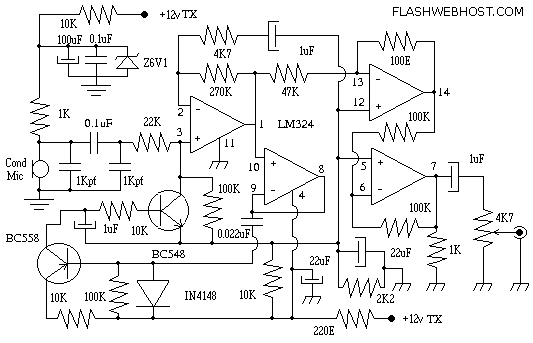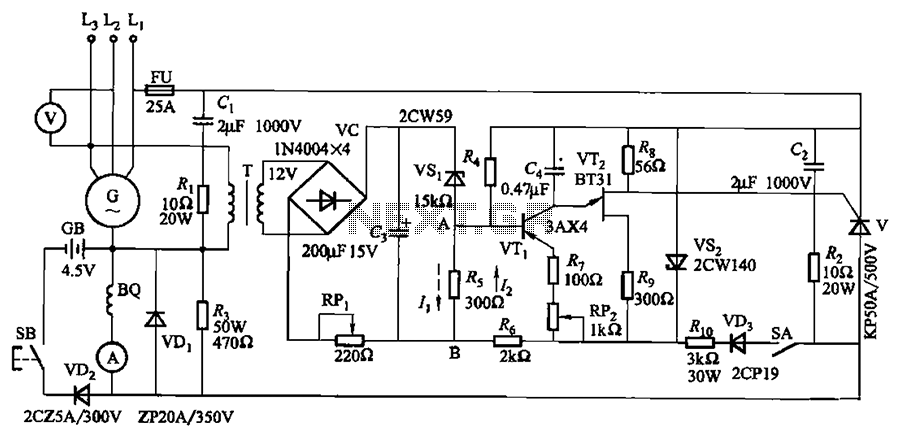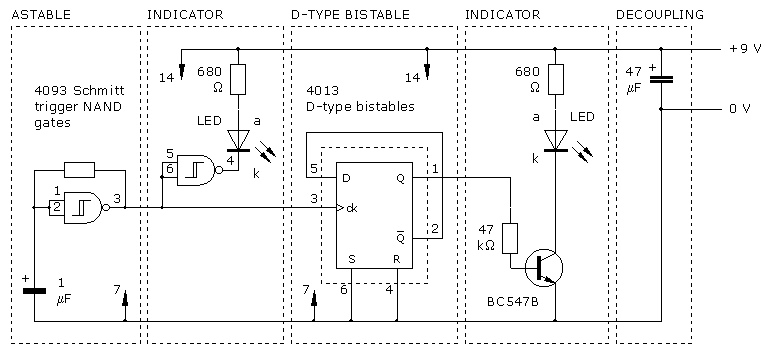
Ambisonic soundfield type Microphone
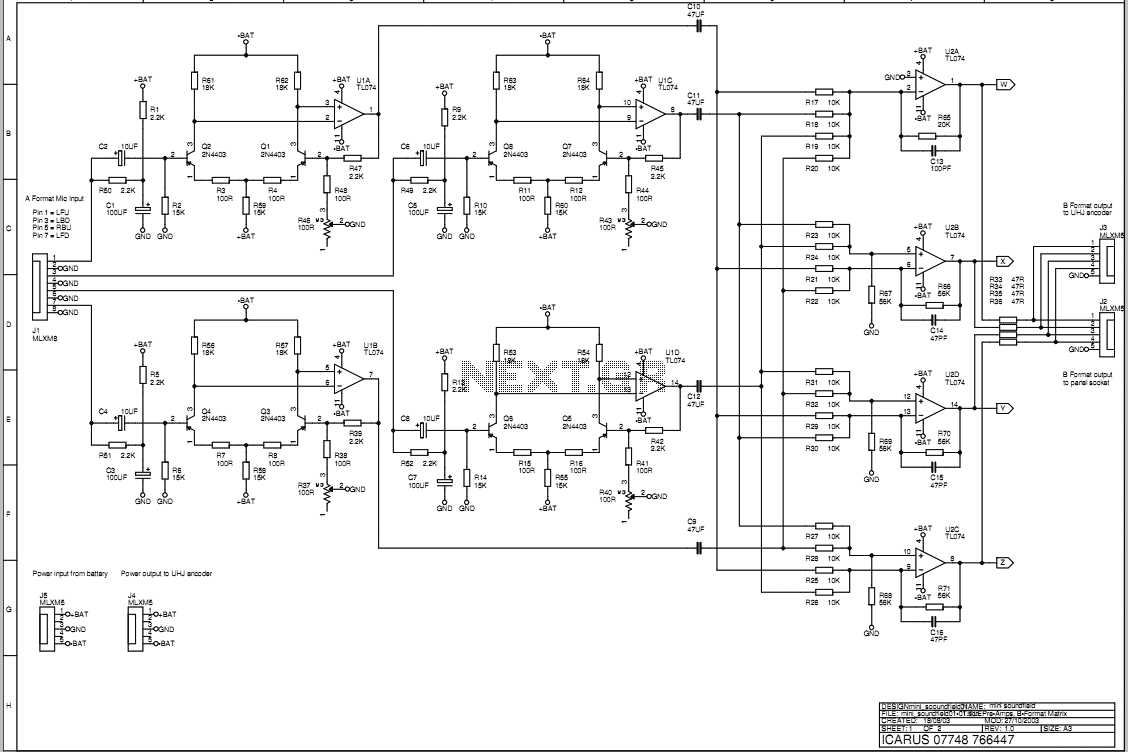
A three-dimensional surround sound Ambisonic recording can be captured using a tetrahedrally arranged quartet of cardioid pattern microphone capsules connected to some simple circuitry to convert the outputs to a standard B-format signal. B-format signals represent a 3D soundfield with four signals; X,Y and Z representing three orthogonal figure of eight patterns and an omnidirectional W reference signal. The commercially available product is very high-end in both quality and price. This article describes a lower quality but much cheaper version for experimentation. For more info, try a search for ambisonics; There is a good page at the university of York. UHJ in this instance is a stereo compatible phase matrixed method of cramming horizontal surround only B-format W, X and Y signals into 2 stereo channels. This can be decoded back into B-format W, X and Y for playback into a B-format to speaker feed decoder. The most basic requirement for the project is for some cheap, fair quality cardioid pattern microphone capsules which must be physically small in size. The first attempt at this microphone used 6mm diameter capsules made by Horn in China which I bought from Mouser in the USA under code #252-EM6050U-514. EMU6050U is the Horn part code. These were just too noisy even for a cheap microphone. The second attempt uses Panasonic WM-56A103. These are 9.5mm modules which have higher output and a much better S/N ratio. The performance is hardly professional but reaches a level which I think could have real practical uses. The Horn mics claim similar noise performance to the Panasonic mics and better low end frequency response. You only have to listen to hear that this simply isn't true. The circuitry overall runs from +/-9V battery supplies. The system will continue working normally right down to 6V rails with reduced headroom, so can be run from two 8.4V nickel rechargeable PP3 batteries, or can take 9V alkaline batteries down to almost full discharge. The mic bias voltage comes direct from the +BAT supply and this is filtered heavily with the 2K2 -100uF combination. Any noise on this bias supply will appear along with the microphone signal so it has to be quiet. As the batteries discharge there will be a gradual and slight gain reduction but this is preferable to running the mic bias and pre-amp stages from regulated supplies, as they have to be quite low voltage to avoid going into dropout. Absence of regulators also saves battery current. The Panasonic WM-55A103 is the back electret close relative of the 56A which I also bought 10 of, as I was puzzled as to why they were more expensive when the others had a seemingly better headline specification. I've been told since that this is a higher quality unit than the foil electret, so potential constructors may choose to go for the WM-55A103 instead. The difference between the two is obscured by the idealised frequency response chart on the data sheet. In the dim and distant past a battery powered prototype soundfield microphone control box had a UHJ encoder included. What a great idea! Well with this design you can also record on location direct to UHJ with your stereo minidisc recorder, or even your dusty old cassette Pro-Walkman. This is ideal for capturing live events where you're not intending to do any further mixing on the result, and is in keeping with the inexpensive ethic of this design. So here we have a built-in UHJ encoder for interfacing to standard stereo recorders which are extremely commonplace. The UHJ converter is built on a separate board from the A to B format converter. The B format signal enters on a 5-way Molex connector and goes to the phase shifters. These are based on what I think are original Gerzon paper time constants, but I'm not sure of the source as I only have a fragment of the full document. The circuit is simple and doesn't use the strange capacitor values found in the Audio and Design UHJ transcoder and decoder. I buy a bunch of good quality capacitors and measure the capacitance with my cheapie old multimeter which can just about manage 1% precision. Generally, I can find plenty within 1% out of a bunch of 20 units and this is much cheaper than buying 1% versions. This is close enough for me. If I can't find enough within 1% then I change the resistor value in the time constant to compensate, which is what I've done in the real circuit. The filters are 8 pole and cover 30 to 16kHz with +/-1.3degrees error assuming perfect components. In real life +/-2% is probably closer to reality but this should still provide very good operation. The UHJ encoding equations require relative 0 and 90 degree versions of W and X signals and just a relative 0 degrees for Y. After the phase shifters, the signals are summed according to the equations below where the j means you take the output from the 90 degree shifter.
The system employs a tetrahedral arrangement of four cardioid microphones to capture a three-dimensional soundfield, which is subsequently processed into a B-format signal. Each microphone capsule is connected to a preamplifier circuit designed to convert the analog signals into a format suitable for further processing. The B-format consists of four channels: W (omnidirectional), X, Y, and Z, with X and Y representing the horizontal plane and Z capturing vertical sound information.
The choice of microphone capsules is critical for achieving the desired sound quality. The Panasonic WM-56A103 capsules are preferred due to their higher output and improved signal-to-noise ratio (SNR) compared to other options. The microphone biasing circuit is powered by a dual +/-9V supply, which can operate down to +/-6V, allowing for flexibility in power source options. This design choice minimizes the need for voltage regulation, which can introduce noise and power consumption issues.
The UHJ encoding process is facilitated by a dedicated circuit board that takes the B-format signals and processes them into a stereo-compatible format. This involves phase shifting the signals to create the necessary 0 and 90-degree versions for W and X, while Y remains at 0 degrees. The phase shifters utilize time constants derived from established methods, ensuring accurate signal processing. The resulting UHJ signal can be recorded directly onto standard stereo recording devices, making the system practical for various applications, including live event recording.
The filtering stage employs eight-pole filters to ensure that the frequency response remains within the desired range of 30 Hz to 16 kHz, maintaining signal integrity across the audio spectrum. The design allows for slight variations in component values, which can be compensated for in the circuit, ensuring reliable performance even with non-ideal components. Overall, this system provides an accessible and cost-effective means to capture and encode three-dimensional sound for a variety of recording scenarios.A three-dimensional surround sound Ambisonic recording can be captured using a tetrahedrally arranged quartet of cardioid pattern microphone capsules connected to some simple circuitry to convert the outputs to a standard B-format signal. B-format signals represent a 3D soundfield with four signals; X,Y and Z representing three orthogonal figure of eight patterns and an omnidirectional W reference signal.
The commercially available product is very "high-end" in both quality and price. This article describes a lower quality but much cheaper version for experimentation. For more info, try a search for ambisonics; There is a good page at the university of York. UHJ in this instance is a stereo compatible phase matrixed method of cramming horizontal surround only B-format W, X and Y signals into 2 stereo channels. This can be decoded back into B-format W, X and Y for playback into a B-format to speaker feed decoder.
The most basic requirement for the project is for some cheap, fair quality cardioid pattern microphone capsules which must be physically small in size. The first attempt at this microphone used 6mm diameter capsules made by Horn in China which I bought from Mouser in the USA under code #252-EM6050U-514.
EMU6050U is the Horn part code. These were just too noisy even for a cheap microphone.The second attempt uses Panasonic WM-56A103. These are 9.5mm modules which have higher output and a much better S/N ratio. The performance is hardly professional but reaches a level which I think could have real practical uses. The Horn mics claim similar noise performance to the Panasonic mics and better low end frequency response.
You only have to listen to hear that this simply isn't true. The circuitry overall runs from +/-9V battery supplies. The system will continue working normally right down to 6V rails with reduced headroom, so can be run from two 8.4V nickel rechargeable PP3 batteries, or can take 9V alkaline batteries down to almost full discharge. The mic bias voltage comes direct from the +BAT supply and this is filtered heavily with the 2K2 -100uF combination.
Any noise on this bias supply will appear along with the microphone signal so it has to be quiet. As the batteries discharge there will be a gradual and slight gain reduction but I consider this to be preferable to running the mic bias and pre-amp stages from regulated supplies, as they have to be quite low voltage to avoid going into dropout. Absence of regulators also saves battery current. The Panasonic WM-55A103 is the back electret close relative of the 56A which I also bought 10 of, as I was puzzled as to why they were more expensive when the others had a seemingly better headline specification.
I've been told since that this is a higher quality unit than the foil electret, so potential constructors may choose to go for the WM-55A103 instead. The difference between the two is obscured by the idealised frequency response chart on the data sheet.
In the dim and distant past a battery powered prototype soundfield microphone control box had a UHJ encoder included. What a great idea! Well with this design you can also record on location direct to UHJ with your stereo minidisc recorder, or even your dusty old cassette Pro-Walkman.
This is ideal for capturing live events where you're not intending to do any further mixing on the result, and is in keeping with the inexpensive ethic of this design. So here we have a built-in UHJ encoder for interfacing to standard stereo recorders which are extremely commonplace.
The UHJ converter is built on a separate board from the A to B format converter. The B format signal enters on a 5-way Molex connector and goes to the phase shifters. These are based on what I think are original Gerzon paper time constants, but I'm not sure of the source as I only have a fragment of the full document. The circuit is simple and doesn't use the strange capacitor values found in the Audio and Design UHJ transcoder and decoder.
I buy a bunch of good quality capacitors and measure the capacitance with my cheapie old multimeter which can just about manage 1% precision. Generally I can find plenty within 1% out of a bunch of 20 units and this is much cheaper than buying 1% versions.
This is close enough for me. If I can't find enough within 1% then I change the resistor value in the time constant to compensate, which is what I've done in the real circuit. The filters are 8 pole and cover 30 to 16kHz with +/-1.3degrees error assuming perfect components. In real life +/-2% is probably closer to reality but this should still provide very good operation. The UHJ encoding equations require relative 0 and 90 degree versions of W and X signals and just a relative 0 degrees for Y.
After the phase shifters the signals are summed according to the equations below where the j means you take the output from the 90 degree shifter. 🔗 External reference
The system employs a tetrahedral arrangement of four cardioid microphones to capture a three-dimensional soundfield, which is subsequently processed into a B-format signal. Each microphone capsule is connected to a preamplifier circuit designed to convert the analog signals into a format suitable for further processing. The B-format consists of four channels: W (omnidirectional), X, Y, and Z, with X and Y representing the horizontal plane and Z capturing vertical sound information.
The choice of microphone capsules is critical for achieving the desired sound quality. The Panasonic WM-56A103 capsules are preferred due to their higher output and improved signal-to-noise ratio (SNR) compared to other options. The microphone biasing circuit is powered by a dual +/-9V supply, which can operate down to +/-6V, allowing for flexibility in power source options. This design choice minimizes the need for voltage regulation, which can introduce noise and power consumption issues.
The UHJ encoding process is facilitated by a dedicated circuit board that takes the B-format signals and processes them into a stereo-compatible format. This involves phase shifting the signals to create the necessary 0 and 90-degree versions for W and X, while Y remains at 0 degrees. The phase shifters utilize time constants derived from established methods, ensuring accurate signal processing. The resulting UHJ signal can be recorded directly onto standard stereo recording devices, making the system practical for various applications, including live event recording.
The filtering stage employs eight-pole filters to ensure that the frequency response remains within the desired range of 30 Hz to 16 kHz, maintaining signal integrity across the audio spectrum. The design allows for slight variations in component values, which can be compensated for in the circuit, ensuring reliable performance even with non-ideal components. Overall, this system provides an accessible and cost-effective means to capture and encode three-dimensional sound for a variety of recording scenarios.A three-dimensional surround sound Ambisonic recording can be captured using a tetrahedrally arranged quartet of cardioid pattern microphone capsules connected to some simple circuitry to convert the outputs to a standard B-format signal. B-format signals represent a 3D soundfield with four signals; X,Y and Z representing three orthogonal figure of eight patterns and an omnidirectional W reference signal.
The commercially available product is very "high-end" in both quality and price. This article describes a lower quality but much cheaper version for experimentation. For more info, try a search for ambisonics; There is a good page at the university of York. UHJ in this instance is a stereo compatible phase matrixed method of cramming horizontal surround only B-format W, X and Y signals into 2 stereo channels. This can be decoded back into B-format W, X and Y for playback into a B-format to speaker feed decoder.
The most basic requirement for the project is for some cheap, fair quality cardioid pattern microphone capsules which must be physically small in size. The first attempt at this microphone used 6mm diameter capsules made by Horn in China which I bought from Mouser in the USA under code #252-EM6050U-514.
EMU6050U is the Horn part code. These were just too noisy even for a cheap microphone.The second attempt uses Panasonic WM-56A103. These are 9.5mm modules which have higher output and a much better S/N ratio. The performance is hardly professional but reaches a level which I think could have real practical uses. The Horn mics claim similar noise performance to the Panasonic mics and better low end frequency response.
You only have to listen to hear that this simply isn't true. The circuitry overall runs from +/-9V battery supplies. The system will continue working normally right down to 6V rails with reduced headroom, so can be run from two 8.4V nickel rechargeable PP3 batteries, or can take 9V alkaline batteries down to almost full discharge. The mic bias voltage comes direct from the +BAT supply and this is filtered heavily with the 2K2 -100uF combination.
Any noise on this bias supply will appear along with the microphone signal so it has to be quiet. As the batteries discharge there will be a gradual and slight gain reduction but I consider this to be preferable to running the mic bias and pre-amp stages from regulated supplies, as they have to be quite low voltage to avoid going into dropout. Absence of regulators also saves battery current. The Panasonic WM-55A103 is the back electret close relative of the 56A which I also bought 10 of, as I was puzzled as to why they were more expensive when the others had a seemingly better headline specification.
I've been told since that this is a higher quality unit than the foil electret, so potential constructors may choose to go for the WM-55A103 instead. The difference between the two is obscured by the idealised frequency response chart on the data sheet.
In the dim and distant past a battery powered prototype soundfield microphone control box had a UHJ encoder included. What a great idea! Well with this design you can also record on location direct to UHJ with your stereo minidisc recorder, or even your dusty old cassette Pro-Walkman.
This is ideal for capturing live events where you're not intending to do any further mixing on the result, and is in keeping with the inexpensive ethic of this design. So here we have a built-in UHJ encoder for interfacing to standard stereo recorders which are extremely commonplace.
The UHJ converter is built on a separate board from the A to B format converter. The B format signal enters on a 5-way Molex connector and goes to the phase shifters. These are based on what I think are original Gerzon paper time constants, but I'm not sure of the source as I only have a fragment of the full document. The circuit is simple and doesn't use the strange capacitor values found in the Audio and Design UHJ transcoder and decoder.
I buy a bunch of good quality capacitors and measure the capacitance with my cheapie old multimeter which can just about manage 1% precision. Generally I can find plenty within 1% out of a bunch of 20 units and this is much cheaper than buying 1% versions.
This is close enough for me. If I can't find enough within 1% then I change the resistor value in the time constant to compensate, which is what I've done in the real circuit. The filters are 8 pole and cover 30 to 16kHz with +/-1.3degrees error assuming perfect components. In real life +/-2% is probably closer to reality but this should still provide very good operation. The UHJ encoding equations require relative 0 and 90 degree versions of W and X signals and just a relative 0 degrees for Y.
After the phase shifters the signals are summed according to the equations below where the j means you take the output from the 90 degree shifter. 🔗 External reference
